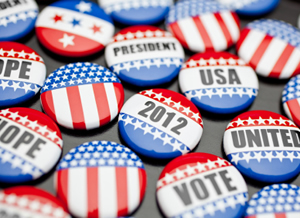
Why Elections Are Good For Bank Stocks
 Keefe, Bruyette & Woods’ [research] team is out with the note: “The Election Edge: Elections Have Historically Benefited Financials,” which reviews the impact of recent U.S. presidential elections on the equity market and financial stocks.
Keefe, Bruyette & Woods’ [research] team is out with the note: “The Election Edge: Elections Have Historically Benefited Financials,” which reviews the impact of recent U.S. presidential elections on the equity market and financial stocks.
While performance trends from the ’08 election are undeniably impacted by the financial crisis, we still found several overarching trends. For a longer performance history, we used the NASDAQ Bank Index to measure trends in bank stocks around elections back to 1984, the first year the exchanges were open on Election Day. We are unable to replicate such long-dated analyses for the other financial industry groups due to lack of industry index data prior to 1995 and in some instances, the lack of an investable public equity universe historically (e.g., REITs).
- Financial stocks rallied and outperformed the market going into three of the last four presidential Election Days. Financials outperformed the market and posted gains in the YTD period up to Election Day in ’04, ’00 and ’96. This outperformance did not hold true in ’08, when financials were impacted by the financial crisis. However, similar trends are playing out in ’12 through 9/21 as financials increased 21.8 percent while the S&P 500 index (SPX) rose 16.1 percent.
- Among financials, banks consistently outperformed the market going into the last four elections. Both large and small to mid-cap banks (SMID) outperformed the SPX in the ’08, ’04, ’00 and ’96 elections. As with the financials, similar trends are playing out in ’12, with the large-cap banks rising 27.5 percent and SMID-cap banks increasing 17.6 percent, both outperforming the SPX’s 16.1 percent gain.
- Longer-term analysis back to the 1984 election shows similar outperformance trends for banks. Banks as represented by the NASDAQ Bank Index outperformed the SPX during the year-to-date period up to Election Day in all seven presidential elections going back to 1984.
- Similar performance trends hold true for the four-week period leading up to Election Day. Financials outperformed in the ’08, ’00 and ’96 elections over the four weeks prior to Election Day while banks (large- and SMID-cap) outperformed during this period in all four last elections. Banks, as represented by the NASDAQ Bank Index, also outperformed in this four-week period prior to Election Day in every election since ’92.
- Election Day is not historically a market-moving event. With the exception of 2008, the SPX rose between 0 to 1 percent on Election Day. Financials exhibited similar performance, ranging from a decline of 0.4 percent to a gain of 1.6 percent in the ’96-’04 elections.
- Financial stocks underperformed post-Election Day through year-end in three of the last four presidential elections. Financials lost their steam once the election was over, underperforming the market in the post-election period in ’08, ’04 and ’96.
- Despite the underperformance of financials, life insurers and diversified financials outperformed post-Election Day through year-end in three of the last four elections. Life insurers and diversified financials underperformed the market and posted losses after only the ’08 election, when performance was significantly impacted by the financial crisis. Long-term post-Election Day results are mixed for the banks, with the NASDAQ Bank Index underperforming the SPX in three of the last seven elections (’08, ’04, ’88).
- Election Day is rapidly nearing and will occur on Tuesday, November 6.

